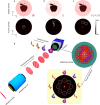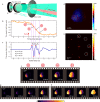Single-shot ultrafast terahertz photography
- PMID: 36973242
- PMCID: PMC10042990
- DOI: 10.1038/s41467-023-37285-3
Single-shot ultrafast terahertz photography
Abstract
Multidimensional imaging of transient events has proven pivotal in unveiling many fundamental mechanisms in physics, chemistry, and biology. In particular, real-time imaging modalities with ultrahigh temporal resolutions are required for capturing ultrashort events on picosecond timescales. Despite recent approaches witnessing a dramatic boost in high-speed photography, current single-shot ultrafast imaging schemes operate only at conventional optical wavelengths, being suitable solely within an optically-transparent framework. Here, leveraging on the unique penetration capability of terahertz radiation, we demonstrate a single-shot ultrafast terahertz photography system that can capture multiple frames of a complex ultrafast scene in non-transparent media with sub-picosecond temporal resolution. By multiplexing an optical probe beam in both the time and spatial-frequency domains, we encode the terahertz-captured three-dimensional dynamics into distinct spatial-frequency regions of a superimposed optical image, which is then computationally decoded and reconstructed. Our approach opens up the investigation of non-repeatable or destructive events that occur in optically-opaque scenarios.
© 2023. The Author(s).
Conflict of interest statement
The authors declare no competing interests.
Figures




References
-
- Nakagawa K, et al. Sequentially timed all-optical mapping photography (STAMP) Nat. Photon. 2014;8:695–700. doi: 10.1038/nphoton.2014.163. - DOI
-
- Fleury R, Monticone F, Alù A. Invisibility and cloaking: origins, present, and future perspectives. Phys. Rev. Appl. 2015;4:037001. doi: 10.1103/PhysRevApplied.4.037001. - DOI
LinkOut - more resources
Full Text Sources

